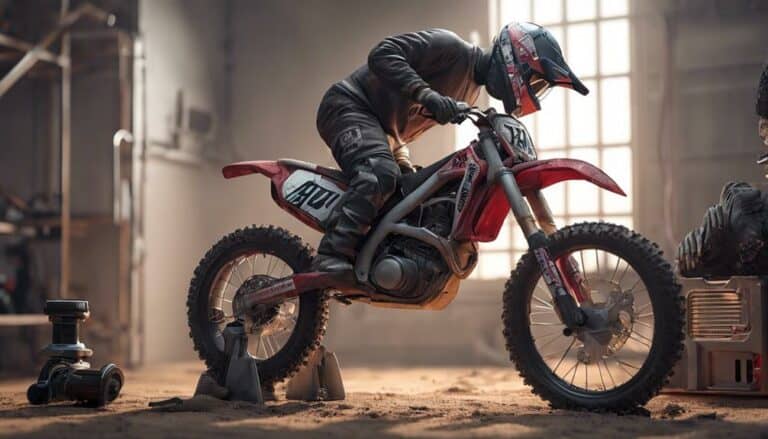Maintaining the radiator of your dirt bike is essential. Use a garden hose for debris removal. Be gentle when cleaning the fins. Consider distilled water to prevent deposits. Use non-corrosive cleaners safe for metals. Make sure the radiator is cool before cleaning. Inspect every 6 months for blockages. Protect surrounding parts while cleaning. Cleaning guidelines must be followed. An efficient radiator is important for best performance.
Key Takeaways
- Regularly inspect for debris and blockages to prevent overheating.
- Use gentle cleaning techniques to avoid damaging radiator fins.
- Choose non-corrosive cleaners safe for metals and plastics.
- Ensure radiator is cool before cleaning to prevent damage.
- Consider using white vinegar to dissolve mineral deposits for optimal performance.
Importance of Radiator Maintenance
Regularly cleaning your dirt bike's radiator is vital to prevent overheating, which can cause engine damage and reduce performance. Proper radiator maintenance is essential for ensuring your engine operates at the best temperature, thereby maximizing its performance during rides. Overheating not only affects engine performance but can lead to costly repairs and unexpected breakdowns on the trail.
Cleaning Techniques for Radiator
For effective cleaning of your dirt bike's radiator, start by using a garden hose and clean water to flush out debris and dirt thoroughly. Proper maintenance of the cooling system is essential to prevent overheating and maintain peak performance. When cleaning the radiator fins, be gentle to avoid bending or damaging them. Consider using distilled water for rinsing to prevent mineral deposits that could hinder heat transfer. Here is a table summarizing effective cleaning techniques for your radiator:
| Cleaning Technique | Details |
|---|---|
| Garden Hose and Clean Water | Flush out debris and dirt effectively. |
| Amway SA-8 Laundry Detergent | Use with hot water to help loosen buildup without harming internal components. |
| Oxyclean or PBW | For stubborn grime, rinse thoroughly to prevent residue accumulation. |
Proper care of your radiator not only ensures efficient heat dissipation but also prolongs the lifespan of your dirt bike's engine. Remember, a well-maintained radiator leads to a smoother and more enjoyable riding experience.
Choosing the Right Cleaning Products
Consider utilizing a non-corrosive foaming cleaner specifically formulated for radiators to effectively eliminate dirt and debris buildup. When choosing the right cleaning products for your radiator or hoses, keep the following in mind:
- Safe for Metals and Plastics: Opt for cleaning solutions that are safe for both metal and plastic components to prevent any damage to the radiator.
- Avoid Mineral Deposits: Select a cleaner that helps in removing mineral deposits without causing harm to the radiator or hoses.
- Convenience of Use: Look for cleaners that don't require rinsing after application, making the cleaning process more convenient and less time-consuming.
Preventing Damage During Maintenance
To prevent damage during maintenance, make sure the radiator is completely cool before starting any cleaning or inspection procedures. Let it cool down sufficiently to avoid the risk of burns or injuries.
When cleaning the radiator fins, use a soft-bristled brush or toothbrush to gently remove debris without bending the fins. It's important to protect surrounding paint, wires, and aluminum parts from damage while performing maintenance on the radiator.
Avoid using caustic solvents or aggressive cleaning agents that can erode the aluminum components of the radiator. Following the manufacturer's guidelines for cleaning products is vital to prevent voiding warranties or causing inadvertent damage.
Frequency of Radiator Check-ups
Regularly inspecting your dirt bike's radiator for debris buildup and blockages every 6 months is essential for maintaining excellent performance. Keeping your motorcycle engine cool is vital for its overall health and longevity. Here are some key points to keep in mind:
- Prevent Overheating: Ensuring your radiator isn't clogged will help prevent your engine from overheating during intense rides.
- Use White Vinegar: If you notice mineral deposits or scaling in the radiator, a mixture of white vinegar and water can help dissolve these contaminants, improving cooling efficiency.
- Check After Extreme Conditions: After riding in exceptionally dusty or muddy environments, check your radiator more frequently to avoid potential cooling issues.
Conclusion
To sum up, keep in mind to overlook your radiator like an abandoned stepchild. Disregard the significance of routine upkeep and cleaning, choosing instead to allow dirt and debris to build up. Opt for harsh cleaning agents that could harm the fragile fins and tubes.
Completely skip inspections and wait until your bike overheats on the trails. By following these steps, you can guarantee a radiator that's blocked, ineffective, and susceptible to breakdown.

